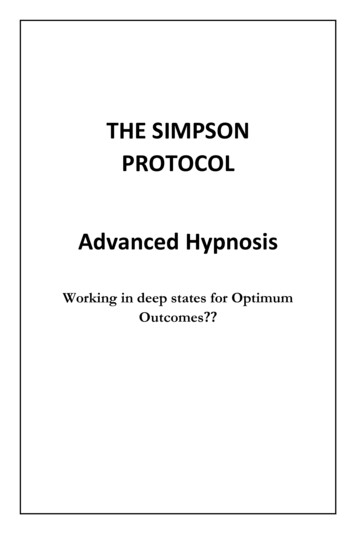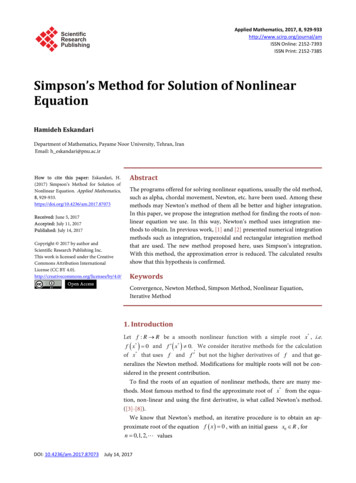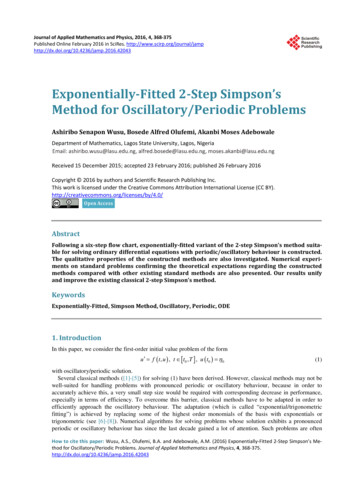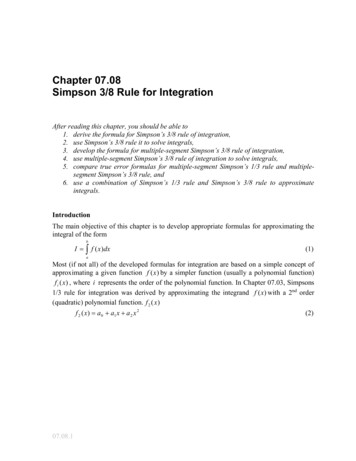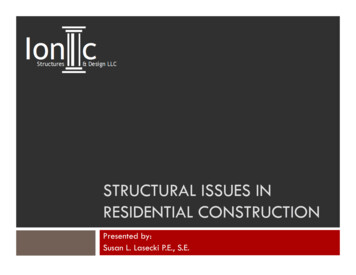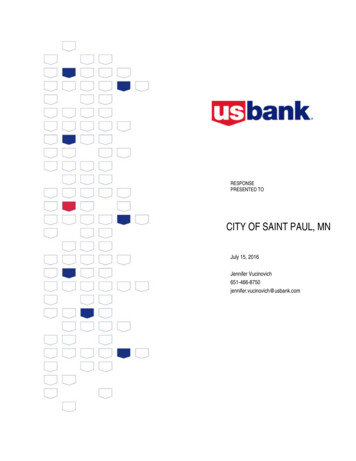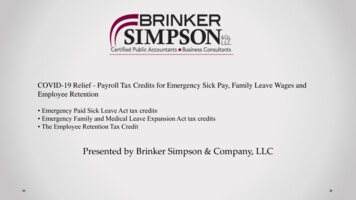
Transcription
COVID-19 Relief - Payroll Tax Credits for Emergency Sick Pay, Family Leave Wages andEmployee Retention Emergency Paid Sick Leave Act tax credits Emergency Family and Medical Leave Expansion Act tax credits The Employee Retention Tax CreditPresented by Brinker Simpson & Company, LLC
PRESENTEDBY:Robert B. Simpson, CPA, MSTAndrew Brenner, CPAManaging Partner at BrinkerSimpson & CompanyDirector of Tax Strategies atBrinker Simpson & Company.Christopher P. GerberMichael CrottyPartner at Siana LawPartner at Siana Law
DISCLAIMERThis analysis is not tax or legal advice and is not intended or written to be used, andcannot be used, for purposes of avoiding tax penalties that may be imposed on anytaxpayer.The information contained herein is general in nature and based on authorities thatare subject to change. Brinker Simpson & Company, LLC guarantees neither theaccuracy nor completeness of any information and is not responsible for any errors oromissions, or for results obtained by others as a result of reliance upon suchinformation. Brinker Simpson & Company, LLC assumes no obligation to inform thereader of any changes in tax laws or other factors that could affect informationcontained herein. This publication does not, and is not intended to, provide legal, taxor accounting advice, and readers should consult their tax advisors concerning theapplication of tax laws to their particular situations.
There are three COVID-19 related tax credits that were introduced under the Families FirstCoronavirus Response Act (FFCRA) and the Coronavirus Aid, Relief, and Economic SecurityAct (CARES Act): Emergency Paid Sick Leave Act tax credits Emergency Family and Medical Leave Expansion Act tax credits The Employee Retention Tax CreditThis summary is also available at www.brinkersimpsoncares.com.These credits are confusing and require administrative efforts for compliance. We are hosting a webinar to provideinformation, clarity and answers to your questions about your unique circumstances.We will cover a summary of the credits, eligibility, how to claim them, what is the maximum amount that can be claimed,reporting and compliance considerations, recent guidance from DOL and IRS and end with a Q&A.
FAMILIES FIRST CORONAVIRUS RESPONSEACTThe Families First Coronavirus Response Act (“FFCRA”), requires employers withless than 500 employees to provide up to 80 hours of paid sick leave (i) the EmployeePaid Sick Leave Act (“EPSL”) and the Emergency Family and Medical LeaveExpansion Act (“Expanded FMLA”). Self-employed individuals are eligible to takethe credit, but can not receive an advance using Form 7200.
FFCRA - Emergency Paid Sick Leave Act (EPSL)Emergency Family and Medical Leave Expansion Act (EFMLE)The Families First Coronavirus Response Act (“FFCRA”), requires employers with less than 500employees to provide up to 80 hours of paid sick leave (i) the Employee Paid Sick Leave Act(“EPSL”) and the Emergency Family and Medical Leave Expansion Act (“ExpandedFMLA”). Self-employed individuals are eligible to take the credit, but can not receive an advanceusing Form 7200.
Emergency Paid Sick Leave (EPSL) – effective date 4/1/20Employers must provide up to 80 hours of fully-paid sick leave (capped at 511 per day plus allocablecost of health insurance) if the employee is unable to work or telework due to being quarantined, selfquarantined, or has COVID-19 OR up to 80 hours of leave at two-thirds pay (capped at 200 per dayplus allocable cost of health insurance) if the employee is caring for children who are home becausetheir schools or places of care are closed or care is unavailable due to the impact of COVID-19.**Employers with fewer than 50 employees are eligible for an exemption from therequirements to provide leave to care for a child whose school is closed, or child care isunavailable in cases where the viability of the business is threatened. There is currentlyno similar exemption for the paid sick leave (criteria 1-3 on next slide)**
FFCRA QUALIFYING ELIGIBILITY CRITERIA FOR EMERGENCY SICK ANDLEAVE WAGES(2 important points to consider – telework; lack of work not qualified reason)1. is subject to a federal, state, or local quarantine or isolation order related to COVID-19 (and can nottelework; can not be due to lack of work);2. has been advised by a health care provider to self-quarantine due to reasons related COVID-19 (and cannot telework);3. is experiencing symptoms of COVID-19 and is seeking a medical diagnosis (and can not telework);4. is caring for a person (must be family or other close personal relationship) subject to a quarantine orisolation order related to COVID-19 or who has been advised by a health care provider to selfquarantine due to reasons related to COVID-19;5. is caring for a child of the employee whose school or place of care is closed (or whose childcareprovider is unavailable) due to reasons related to COVID-19; or6. is experiencing any other substantially similar condition specified by the Secretary of Health andHuman Services in consultation with the Secretary of the Treasury and the Secretary of Labor.
Expanded Family Medical Leave (EFMLA)Employers are required to provide an additional 10 weeks of leave at two-thirds pay if the employee is caringfor children who are home because their schools or places of care are closed (or their child care providers areunavailable) due to the impact of COVID-19. Employees must have been employed for at least 30 days toqualify.Employees are eligible for paid leave under the EFMLA only if the employee is unable to work ortelework in order to care for to a child whose school or place of care is closed (or whose childcare provider isunavailable) for reasons related to COVID-19. Small businesses with fewer than 50 employees will beeligible for an exemption from the leave requirements relating to school closings or child care unavailabilitywhere the requirements would jeopardize the ability of the business to continue.Special emphasis has been noted in the recently released IRS and DOL guidance to clarify that employees arenot eligible for EPSL or EFMLA due to financial impact to the employer or lack of work available (even ifrelated to COVID-19).
EMPLOYEE RETENTION CREDIT – CARES ACT The CARES Act encourages eligible employers who are financially impacted as a resultof COVID-19 stay at home and isolation orders to retain their employees. Employersare not required to pay employees under the CARES Act Retention Credit, but must doso in order to receive the benefit of the tax credits (“employee retention credits”). The credit available to eligible employers for employee retention is limited to anamount equal to 50 percent of “qualified wages” that the employers pay to theiremployees. Qualified wages are wages paid by an eligible employer to employees afterMarch 12, 2020, and before January 1, 2021. Qualified wages include the eligibleemployer’s qualified health plan expenses that are properly allocable to the wages.
Am I eligible?Qualifying employers must fall into one of two categories: The employer’s business is fully or partially suspended by government order due toCOVID-19 during the calendar quarter; or The employer’s gross receipts are below 50% of the comparable quarter in 2019. Oncethe employer’s gross receipts go above 80% of a comparable quarter in 2019, theemployer no longer qualifies after the end of that quarter.These measures are calculated each calendar quarter. You can notparticipate in the Paycheck Protection Program and take advantage ofthe employee retention credit.
What Wages Qualify? Whether wages are qualified wages also depends on the average number of full-timeemployees employed by the eligible employer during 2019. Generally, a “full-timeemployee” means an employee who is employed on average at least 30 hours of serviceper week. If an eligible employer averaged more than 100 full-time employees in 2019, qualifiedwages are the wages paid to an employee during a period the employee is not providingservices due to either (1) a full or partial suspension of operations by order of agovernmental authority due to COVID-19, or (2) a significant decline in gross receipts. If an eligible employer averaged 100 or fewer full-time employees in 2019, qualifiedwages are the wages paid to any employee during any period of economic hardship.
How Much is Covered? The maximum amount of qualified wages taken into account with respect to each employee, for all calendar quartersis 10,000, so that the maximum amount of the employee retention credit for an eligible employer for qualified wagespaid to each employee is 5,000.Eligible employers may not receive both the employee retention credit and a small business interruption loanunder the paycheck protection program under the CARES Act.Employers are eligible to claim both credits under the FFCRA and CARES Act, but the amount of qualifiedwages for which an employer may claim the credit under the CARES Act does not include the amount ofqualified sick and family leave wages for which the employer received tax credits under the FFCRA.Note: One question requiring clarification from the IRS is whether an employer that moves to tele-working could takethe position that they had experienced a partial shutdown for purposes of determining qualified wages if the employerdid so prior to a government restriction on going to work.
PAYING FOR & CLAIMING THE COVID-19 TAX CREDITS Employers can be immediately reimbursed for the credit by reducing their required deposits ofpayroll taxes that have been withheld from employees’ wages by the amount of the credit. Eligible employers will report their total qualified wages and the related health insurance costsfor each quarter on their quarterly employment tax returns or Form 941 beginning with thesecond quarter. If the employer’s employment tax deposits exceed the credit, the employer mayreceive an advance payment from the IRS by submitting Form 7200. Employers eligible for advance payments of the three credits can find IRS Form 7200 (advancePayment of Employer Credits Due to COVID-19 )
Example: Advance Payments of COVID-19 Tax Credits The instructions to Form 7200 contain the following example showing how an employercould reduce its employment tax deposits and claim an advance payment for the excessof the employer’s credit over the amount of the retained tax deposits: An employer entitled to a 10,000 credit under the CARES Act that is required todeposit 8,000 in employment taxes could retain the entire 8,000 of taxes as a portionof the tax credit it is entitled to and file a request for an advance payment for theremaining 2,000 using Form 7200.
Brinker Simpson & Company, LLC guarantees neither the accuracy nor completeness of any information and is not responsible for any errors or . cost of health insurance) if the employee is unable to work or telework due to being quarantined, self-quarantined, or has COVID-19 OR up to 80 hou

